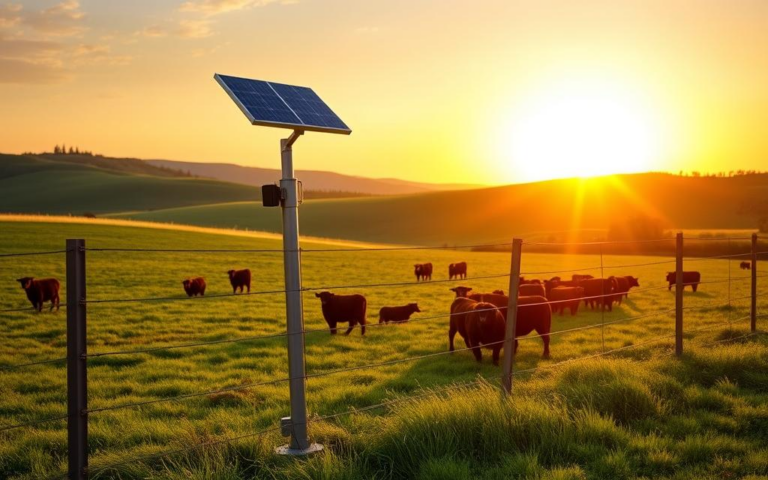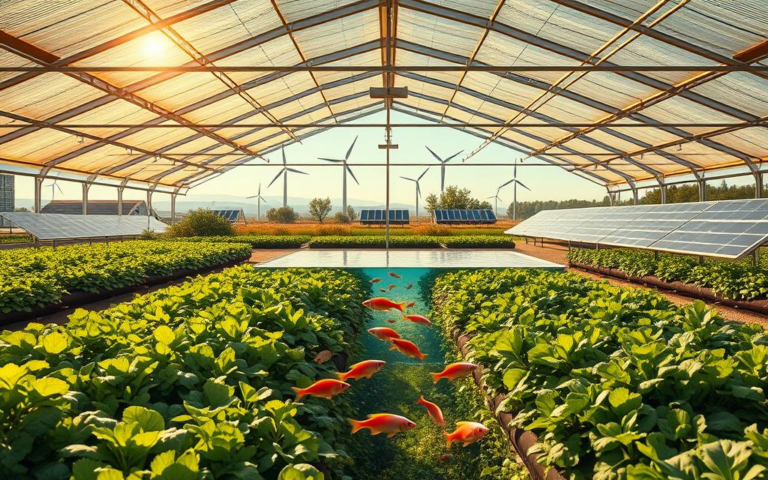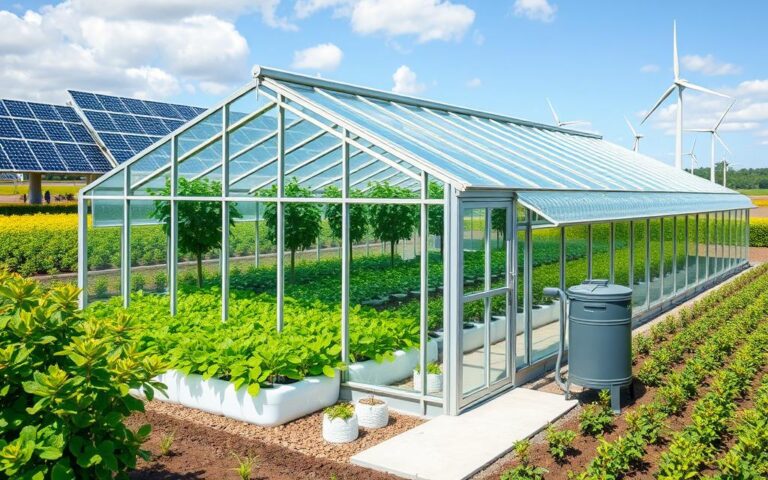Solar electric fencing is changing livestock management for U.S. farmers. This eco-friendly tech offers sustainable ways to protect and manage farm animals. It’s a big step forward in green farming practices.
This technology gives ranchers a powerful tool for livestock control. It combines energy efficiency with practical animal management. Solar power creates secure, cost-effective, and eco-friendly farm perimeters.
Sustainable farming has put solar electric fencing in the spotlight. Ranch owners see it as a smart way to cut costs. It also reduces environmental impact, meeting modern farming needs.
Advanced solar panels create strong boundaries to protect livestock. These fences keep animals safe from predators and prevent wandering. It’s a cutting-edge approach to smart farm management.
Solar electric fencing is the future of efficient livestock care. It’s a practical solution for farmers looking to modernize their operations. This tech continues to evolve, improving farm management strategies.
What is Solar Electric Fencing?
Solar electric fencing is a modern approach to farm boundary management. It uses solar power to create an effective barrier for livestock protection. This system offers farmers a sustainable and efficient way to manage their property.
Farmers now use solar electric fencing for smart, sustainable food production. This tech combines renewable energy with practical farm needs. It’s a powerful tool for managing livestock and protecting crops.

Understanding the Core Functionality
Solar electric fencing works through a simple yet effective mechanism. The system creates electrical pulses that form a barrier for animals. This prevents livestock from crossing set boundaries.
- Utilizes solar panels to generate electrical current
- Provides a humane deterrent for livestock movement
- Enables precise property and grazing area management
Key System Components
The solar electric fencing system has several important parts. These elements work together to create an efficient farm boundary solution.
| Component | Function | Benefit |
|---|---|---|
| Solar Panel | Generates electrical power | Renewable energy source |
| Energizer | Converts solar power into electrical pulses | Consistent barrier protection |
| Conductive Wires | Transmits electrical current | Defines property boundaries |
| Grounding System | Completes electrical circuit | Ensures effective shock delivery |
Solar electric fencing shows how modern farm tech can be sustainable. It uses renewable energy principles to create efficient farming environments. This system proves that eco-friendly solutions can meet practical agricultural needs.
Benefits of Solar Electric Fencing for Farmers
Solar electric fencing offers farmers an innovative solution for sustainable farming. This advanced system provides many advantages beyond traditional livestock containment methods. It bridges technology with eco-friendly agricultural practices.
Cost-Effectiveness
Farmers can cut expenses by using solar electric fencing. The initial investment pays off quickly through long-term savings. These savings come from minimal electricity costs and reduced maintenance.
- Minimal electricity costs
- Reduced maintenance expenses
- Longer fence lifespan compared to traditional systems
Environmental Advantages
Solar electric fencing fits perfectly with eco-friendly farming. It uses renewable energy, helping farmers reduce their carbon footprint. This system maintains effective livestock management while being environmentally friendly.
| Environmental Benefit | Impact |
|---|---|
| Renewable Energy Usage | Reduces greenhouse gas emissions |
| Water Conservation | Supports sustainable farming practices |
| Land Preservation | Minimizes landscape disruption |
Ease of Installation
Farmers can easily add solar electric fencing to their existing systems. The hydroponics-friendly design allows for quick setup without needing much technical know-how.
- Simple component assembly
- No complex electrical wiring
- Adaptable to various farm layouts
Solar electric fencing represents the future of sustainable agricultural infrastructure.
How Solar Electric Fencing Works
Solar electric fencing is a smart way to manage livestock using renewable energy. It keeps farms safe and uses sunlight for power. This system blends solar tech with farm safety, offering a green solution for today’s farmers.
Solar panels turn sunlight into electricity for the fence. Special batteries store this power. This setup keeps the fence running, even when there’s less sun.
Solar Panels and Energy Storage
Key components of the system include:
- Photovoltaic solar panels
- Rechargeable battery units
- Electric fence controller
- Grounding system
This tech helps urban farms and eco-friendly agriculture. Panels gather energy by day. Batteries store extra power for 24/7 fence operation.
Electric Current Flow and Livestock Safety
The fence’s electric current is safe but effective. Animals get a quick, sharp zap when they touch it. This teaches them to stay away without causing harm.
Safety is a top priority in these fences. The low-amp, high-voltage pulse deters animals without hurting them. It’s perfect for farmers who want good boundary control.
Choosing the Right Solar Electric Fencing System
Picking the ideal solar electric fencing system requires careful thought about your farm’s needs. The right system can boost your farm’s security and efficiency. It’s crucial for managing livestock, protecting organic produce, or developing fish farming operations.

When looking at solar electric fencing options, farmers should consider these key factors:
- Farm size and layout
- Type of livestock or crop protection needed
- Local climate conditions
- Budget constraints
- Power requirements
Key Considerations for System Selection
Solar electric fencing tech has grown to support various farming practices. Organic farmers can get precise perimeter control with these systems. Fish farms can use specialized protective systems for their needs.
| System Type | Best For | Power Output |
|---|---|---|
| Compact Solar Charger | Small farms, organic gardens | 0.5-2 joules |
| Mid-Range System | Livestock management | 2-5 joules |
| High-Power System | Large farms, multiple perimeters | 5-10 joules |
Popular Brands to Consider
Top makers like Gallagher, Zareba, and Premier offer reliable solar electric fencing solutions. Each brand has unique features for different farm needs. Their products work for small organic plots to large livestock ranges.
Local farming experts can help you find the best solar electric fencing system. They’ll consider your specific needs and recommend the right option.
Installation Tips for Solar Electric Fencing
Solar electric fencing is a modern solution for sustainable farming and livestock care. Proper setup is key to making your system work well. It also helps create a more eco-friendly farm.
Farmers need to prep their site and gather tools before they start. Good planning and attention to detail are vital for success.
Site Preparation Essentials
- Clear vegetation and debris from the proposed fencing area
- Evaluate terrain for optimal solar panel positioning
- Measure precise property boundaries
- Ensure direct sunlight exposure for solar panels
System Configuration Steps
- Select appropriate solar electric fencing components
- Install ground rods at recommended intervals
- Connect solar panel to battery storage unit
- Test electrical current before full implementation
Critical Safety Precautions
Safety should be the top priority when setting up solar electric fencing. Wear protective equipment and follow the maker’s instructions carefully.
Check connections often and keep proper grounding to avoid electrical dangers. This helps keep both people and animals safe.
Proper installation ensures maximum efficiency and longevity of your solar electric fencing system.
Careful setup creates a strong, eco-friendly farm system. This supports better livestock care while reducing harm to the environment.
Maintenance of Solar Electric Fencing
Proper upkeep of your solar electric fencing is vital for its longevity. It ensures your eco-friendly farm solution stays efficient and reliable. This system helps conserve water while managing livestock effectively.
Maintaining solar electric fencing is easy and straightforward. Its simple design makes it perfect for farmers seeking efficient livestock management. Regular checks keep the system running smoothly.
Routine Checks and Cleaning Procedures
- Inspect solar panels monthly for dust or debris accumulation
- Clean panel surfaces with soft cloth and mild detergent
- Check battery connections for corrosion
- Verify fence wire tension and structural integrity
- Test electrical current strength quarterly
Troubleshooting Common Issues
| Issue | Potential Cause | Solution |
|---|---|---|
| Weak electrical current | Dirty solar panels | Clean panels thoroughly |
| Intermittent power | Battery degradation | Replace battery every 3-5 years |
| Vegetation interference | Overgrown plants | Trim vegetation near fence line |
Solar electric fencing is ideal for eco-conscious farmers. It requires minimal upkeep and supports water conservation efforts. These simple maintenance strategies ensure reliable performance and extend system lifespan.
Pro tip: Keep a maintenance log to track inspections and repairs, helping you anticipate potential issues before they become significant problems.
Comparing Solar Electric Fencing to Traditional Systems
Solar electric fencing is revolutionizing livestock management for farmers. It merges renewable energy with practical farming needs. This technology offers major benefits over traditional fencing methods.
Solar electric fencing is a smart alternative to conventional systems in agriculture. It uses renewable energy tech, similar to hydroponics and aquaponics. This innovative solution provides sustainable and efficient options for farmers.
Cost Analysis Over Time
Solar electric fencing shows impressive long-term cost-effectiveness. Initial costs are higher, but maintenance expenses drop significantly. Solar power generation also minimizes electricity costs.
- Initial installation costs are higher than traditional fencing
- Significant reduction in ongoing maintenance expenses
- Minimal electricity costs due to solar power generation
| Fencing Type | Initial Cost | 5-Year Maintenance Cost | Energy Efficiency |
|---|---|---|---|
| Traditional Fencing | $2,500 | $1,200 | Low |
| Solar Electric Fencing | $3,800 | $400 | High |
Efficiency and Reliability
Solar electric fencing excels in various environmental conditions. The integrated solar panel system ensures consistent power supply. This makes it more reliable than traditional electric or mechanical fences.
- Operates effectively in remote locations
- Minimal infrastructure requirements
- Adaptable to diverse terrain and climate conditions
Solar electric fencing offers farmers cutting-edge renewable energy tech. It protects livestock while reducing environmental impact. This solution also lowers long-term operational costs for farmers.
Real-Life Success Stories
Solar electric fencing has revolutionized farming in the United States. It offers innovative solutions for sustainable livestock management. These real-world examples show its impact on urban farming and organic produce operations.
Breakthrough at Sunnydale Organic Dairy Farm
Sunnydale Organic Dairy Farm in Wisconsin adopted solar electric fencing. They found it to be a game-changer for their sustainable farming approach.
The farm experienced significant benefits from this technology. These included reduced maintenance costs, better livestock control, and improved pasture management.
- 50% reduction in traditional fencing maintenance costs
- Improved livestock containment and protection
- Enhanced pasture management capabilities
Farmer Perspectives on Solar Electric Fencing
Farmers across various agricultural sectors praise solar electric fencing. Urban farmers and organic growers especially value its versatility.
| Farm Type | Benefits Observed | Cost Savings |
|---|---|---|
| Small Urban Farm | Easy installation, low maintenance | 25-35% reduction in fencing expenses |
| Large Organic Ranch | Improved livestock management | 40% decrease in security costs |
| Mixed Produce Farm | Flexible perimeter protection | 30% lower infrastructure investment |
“Solar electric fencing has revolutionized our farm’s operations, providing an eco-friendly and cost-effective solution,” says Mark Richardson, sustainable agriculture expert.
These success stories prove solar electric fencing’s practical value. It’s more than just new tech; it’s a vital tool for modern farming.
Future Trends in Solar Electric Fencing
Solar electric fencing is changing farm tech fast. New ideas are set to change how farms work. Smart systems now let farmers watch fences and animals live through apps.
This tech can help more than just animal farms. It’s useful for fish farms and eco-friendly farming too. Smart fences can spot breaks and check the weather.
These fences give farmers lots of data. This helps them manage their farms better.
Innovations on the Horizon
Tech firms are making solar fences that work with other eco-friendly farm tools. These new fences will link to water systems and drones. They’ll also connect to farm software.
This creates a network of farm tech working together.
Sustainable Agriculture and Technology Integration
Farmers want better, greener ways to work. Solar electric fencing leads the way in eco-friendly farm tech. It cuts down on pollution while keeping animals and crops safe.
More farms are choosing this tech. It helps them be modern and care for nature.
FAQ
What exactly is solar electric fencing?
Solar electric fencing uses solar panels to power an electric fence system. It’s a sustainable way to contain livestock and keep predators out. The system turns sunlight into an effective barrier for farm animals.
How does solar electric fencing work?
Solar panels capture sunlight and convert it into electrical energy stored in a battery. An energizer uses this power to send short, safe electrical pulses through the fence wire.
When an animal touches the fence, it gets a mild shock. This teaches them to avoid crossing the boundary.
Is solar electric fencing safe for livestock?
Yes! The electrical pulse is uncomfortable but not harmful. It delivers a quick shock that teaches animals to avoid the fence. The low-amperage pulse is safe and humane for various types of livestock.
How cost-effective is solar electric fencing compared to traditional fencing?
Solar electric fencing offers significant long-term cost savings. It eliminates electricity costs and needs minimal maintenance. Farmers can recoup their initial investment through reduced energy and maintenance expenses.
Can solar electric fencing work in different climates?
Yes, modern solar electric fencing systems adapt to various climates. Advanced battery storage and efficient solar panels allow the system to work in different weather conditions.
What types of farms can benefit from solar electric fencing?
Solar electric fencing suits many agricultural settings. It works for dairy farms, cattle ranches, sheep and goat farms, and horse paddocks. It’s great for sustainable agriculture practices that prioritize eco-friendly solutions.
How challenging is it to install solar electric fencing?
Installation is straightforward and can be a DIY project for many farmers. The system needs minimal technical expertise. Most manufacturers provide comprehensive installation guides.
Key steps include choosing the right location, setting up solar panels, and installing the energizer and fence wire.
What maintenance does solar electric fencing require?
Maintenance is minimal and includes routine checks such as: – Cleaning solar panels – Checking battery connections – Inspecting fence lines for damage – Ensuring vegetation doesn’t interfere with the fence Most systems are designed for low maintenance, making them attractive to busy farmers.
How does solar electric fencing contribute to sustainable agriculture?
Solar electric fencing supports sustainable agriculture by: – Using renewable solar energy – Reducing carbon footprint – Minimizing environmental impact – Supporting water conservation efforts – Integrating with other eco-friendly farming technologies like aquaponics and hydroponics
Can solar electric fencing be used in urban or small-scale farming?
Yes! Urban farmers and those with smaller operations can use solar electric fencing. These systems adapt to various property sizes, from small hobby farms to larger agricultural enterprises.



